 212 is New York, while the relatively close Boston got 617. 213? Across the country, to Los Angeles. How's this happen?
212 is New York, while the relatively close Boston got 617. 213? Across the country, to Los Angeles. How's this happen?The answer is pictured at the right. It's all because of the rotary phone.
Before 1951, long distance phone calls required an operator's assistance. On November 10, 1951, that ended, as the mayor of Englewood, New Jersey dialed, directly, the major of Alameda, California. (The call took 18 seconds to connect.) In order to get to that point, however, the phone system infrastructure required overhaul; specifically, the addition of a routing system. Enter area codes.
Until recently, all area codes had either a "1" or a "0" as the middle number. This allowed for local calls to be dialed without the area code, as the switching software would recognize a long distance call by the second digit -- local exchanges never had a 0 or 1 in that spot -- and avoid confusion. But the etymology of specific area codes is more complicated. While ZIP codes are roughly geographic (there's a map for that) though, area codes clearly aren't, as New York (originally only 212) isn't near Los Angeles (213) and Detroit (313) abuts neither Chicago (312) nor St. Louis (314).
Rather, area codes were given out with speed in mind. The bigger the city, the less time it takes to dial that city's number on a rotary phone. New York's 212 is a mere five clicks away; Los Angeles and Chicago are next at six; Philadelphia (area code 215) is eight. Rural American places and some Canadian provinces received larger click amounts -- Montana's 406 is twenty clicks while South Dakota's 605 and Nova Scotia's 902 is twenty-one.
This, of course, also means that the typical emergency telephone number, 9-1-1, is rather long (at eleven clicks), almost twice as long as directory information (4-1-1, six clicks). Why pick such a "long" number? The history behind the selection of 9-1-1 has been lost to antiquity, but best guesses include its near-universal availability, ease in remembering it, and the unlikelihood of an unintentional dialing.
Bonus fact: Originally, the middle number -- either 0 or 1 -- in the area code meant something in and of itself. If a state had only one area code, it's area code had a 0. If it had more than one, all area codes therein had a 1. Much like other numbering conventions, this has since been deprecated.

















































